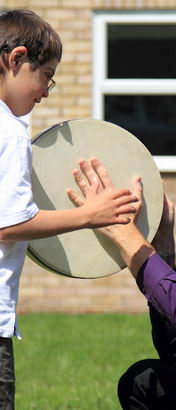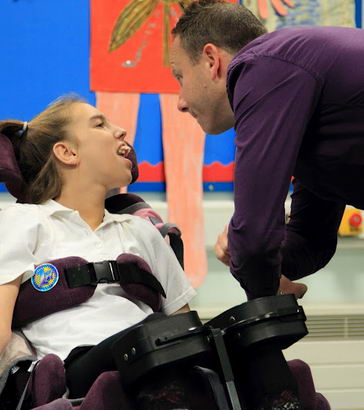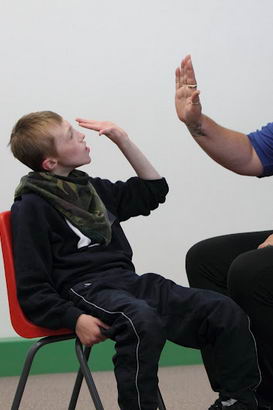
Intensive Interaction is one of the most important advances of the past 20 years. It has made a significant contribution to the development of effective communication curricula for those with complex learning and communication difficulties (Nind and Hewett, 1988; Nind and Hewett, 1994; Hewett and Nind, 1998; Nind and Hewett, 2001; Kellett and Nind, 2003; Caldwell, 2005; Nind and Hewett, 2006; Caldwell, 2007).
Intensive Interaction was born out of two independent but related ideas.
Gentle Teaching, created by J.J. McGee and his New Zealand colleagues (McGee, Menolascino, Hobbs and Menousek, 1987), argued that those with severe learning and communication
difficulties needed to be taught how to have a relationship (how to love and be loved) before we could expect them to learn other skills. This was a reaction against the behaviourist, skills based, teaching pedagogy prevalent at that time.
In the UK, Gary Ephraim was arguing for a holistic communication tool that echoed the natural ways in which mothers interacted
with their very young babies
(Ephraim (1979)).
Those interested in developing their skills should read Nind and Hewett's 2001 A Practical Guide to Intensive Interaction
published by BILD. The Intensive Interaction website is also a good
port of call.
Intensive Interaction fosters early communication skills across child and adult services. It is particularly useful for children with pre-verbal, pre-linguistic, pre-intentional behaviour and/or those who are difficult to reach (often those with PMLD or ASD).
It is based on conventional parent/infant models of interaction and focuses on the communication process from birth. It emphasises that communication is a two-way process and should be nurtured and enjoyed from the start of a child's life. By doing this, we become flexible and responsive partners.
This encourages children to engage fully and empowers children to understand that they can affect the actions of those around them.

Intensive Interaction is not agenda, target or objective driven. Adults respond to the child and follow the child's lead. They celebrate any action or vocalisation as an intentional act of communication – whether it is or not – and in the long term try to extend their knowledge and understanding of communicative interactions.
The adult needs to really get to understand the learner and seek moments where they really communicate with the learner. These engagement/communication windows are key to Intensive Interaction.
In the following clip, Corinna Cartwright, a headteacher, talks about the importance of
Intensive Interaction.
built on?
start using Intensive Interaction?
Intensive Interaction is a process by which children with profound communication difficulties are able to realise that their movements, their sounds and their actions actually convey meaning to others.
Return
built on?
Return
Return

Intensive Interaction works best when the interactor:
- Allows the learner to take control and for the most part, lead the session;
- Is seen by the learner to enjoy the experience of the interaction;
- Gives their total attention to the learner;
- Treats all actions and vocalisations made by the learner as positive attempts to communicate;
- Uses as little language as possible – often hello and goodbye are sufficient for those with PMLD;
- Does not give up too early, either in the session itself or over time – it may take many years to maximise a learner's communicative abilities;
- Documents changes – using recording sheets and videoing some sessions with a static wide angle lens;
- Talks to his/her colleagues and shares experiences in a general plenary involving the learners after every discrete session.

At its best, Intensive Interaction should take place wherever the possibility allows. Schedule at least one regular discrete weekly slot – particularly in the case of PMLD groups. For younger learners, consider arranging slots several times a day.
In certain cases it might be necessary to use Inclusive Interaction techniques exclusively – especially with those who are at the earliest stages of communicative development and are exhibiting extreme challenging behaviours (Imray, 2008).
Intensive Interaction fosters meaningful communicative opportunities with those who might otherwise be considered impossible to reach.

Caldwell, P. (2005) Finding You Finding Me. Using Intensive Interaction to get in touch with people whose severe learning disabilities are combined with autistic spectrum disorder, London: Jessica Kingsley.
Caldwell, P. (2007) From Isolation to Intimacy: Making Friends without Words, London: Jessica Kingsley.
Ephraim, G.W. (1979) Developmental Processes in Mental Handicap: A Generative Structure Approach, unpublished PhD Thesis, Uxbridge: Brunel University, Department of Psychology.
Hewett, D. and Nind, M. (eds) (1998) Interaction in Action: Reflections on the Use of Intensive Interaction, London: David Fulton.
Imray, P. (2008) Turning the Tables on Challenging Behaviour, London: Routledge.
Kellett, M. and Nind, M. (2003) Implementing Intensive Interaction in Schools: Guidance for Practitioners, Managers and Coordinators, London: David Fulton.

McGee, J.J., Menolascino, F., Hobbs, D. and Menousek, P. (1987) Gentle Teaching: A non-aversive approach to helping persons with mental retardation, New York: Human Science Press.
Nind, M. and Hewett, D. (1988) Interaction as Curriculum, British Journal of Special Education 15 (2) 55-57.
Nind, M. and Hewett, D. (1994) Access to Communication: Developing the basics of communication with people with severe learning difficulties through Intensive Interaction, London: David Fulton.
Nind, M. and Hewett, D. (2001) A Practical Guide to Intensive Interaction, Kidderminster: British Institute of Learning Disabilities.
Nind, M. and Hewett, D. (2006) Access to Communication, (2nd edition), London: David Fulton.
